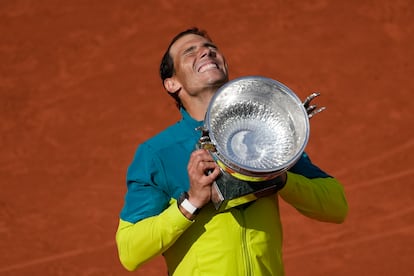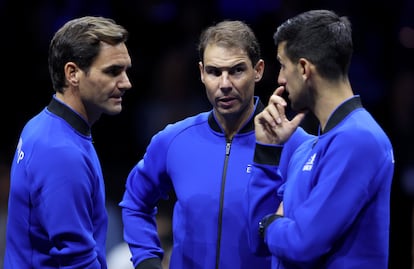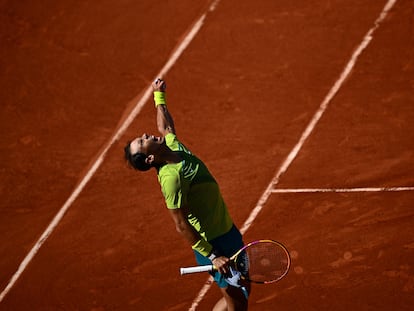Rafael Nadal announces his retirement: ‘A thousand thanks to everyone’
The 22-time Grand Slam champion hangs up his racket after 23 years as a professional as one of the sport’s greatest historical competitors

Rafael Nadal has announced his retirement from tennis. The Spanish player, winner of 22 Grand Slam titles, published a video Thursday on social networks. “I’m retiring from professional tennis. A thousand thanks to everyone,” he said. His final matches will be with the Spanish Davis Cup team in November. To be or not to be, that is the question. And for some time — a year and a half now — Nadal had begun to feel (and accept) that he was no longer a tennis player. Or at least not as he understands it. He had intended to stretch the journey as far as possible, to be able to say goodbye in his own way, competing on the courts where he has enjoyed so many moments of triumph, but fate had reserved for him the same outcome as for so many others: denial. The physical wear and tear, the injuries; the end point of so many sporting greats, including his friend and rival, Roger Federer. Now comes the endgame, hastened by the injury he suffered at the beginning of 2023 in Melbourne; since that tendon rupture and an abrupt disappearance from the limelight, Nadal made several attempts to stage a comeback, submitting to the unpleasant experience of the operating room. Exhausted and close to 40 — he is 38 years old but there are quite a few more in his punished body — Nadal has decided to call time on his storied career. Tennis already considers him another of the great legends of the sport’s iconography.
There is nothing time cannot do, even faced with the immense irreducibility of Nadal. At the beginning of his career this day was expected early due to the physical demands he placed on himself, but as the years progressed and he overcame a host of adversities, it became almost impossible to imagine. After 23 years in the elite and a lifetime wielding the racket, the granite champion, the boy that all of Spain watched grow and succeed — whether they liked tennis or not — has had to submit to the pain he endures. Nadal and his body has always been an all or nothing relationship; heaven and hell, with little middle ground. A year and a half full of heartaches has led to a decision that he, resilient like few others, had tried to delay, but nature has definitively cut its credit and now only Novak Djokovic remains as the last vestige of an extraordinary era in the sport.
Thus ends a journey as spectacular as it was exemplary, full of great successes and a model template. Nadal now transcends as one of the most recognizable symbols in sport, capable of surpassing himself a thousand times over, no matter how much his body broke down; time and again he got up from the canvas, but the law of logic told him to stop. Nadal is now looking toward that tomorrow he began to glimpse two years ago, when his left foot, plagued by Müller-Weiss syndrome, a chronic condition, had already led him to think about retiring.
That foot was a stumbling block from the very beginning. Always threatening, the condition did not manage to knock him off course, but in the last couple of years the daily routine of training has not been as he would like and eventually guided him towards that second life of athletes. Too many frustrated attempts, one step forward, two steps back, of not being able to train with the intensity he was accustomed to. Consequently, the farewell finally arrives and tennis, in its entirety, bows to one of its great talents, recognizable by his mental strength and his powerful topspin forehand, arguably one of the most damaging shots in history. Nadal wanted more, but this time he could find no way out. He fought until the last ball.

The King of Clay
Nadal hangs up his racket as the undisputed King of Clay, a dominant presence on the most strategic and demanding surface, with 92 titles to his name — 14 of them at Roland Garros and a total of 63 on clay — and with the seal of the fiercest competitor, capable of storming Federer’s fiefdom and going toe-to-toe in the melee with Djokovic. He knew how to adapt to the frenetic pace of modern tennis and to perpetuate himself. He changed the form, but not the substance. From his thirties, there was no more flowing mane or pirate shorts, but the spirit was the same as that boy who woke up at 7 a.m. every day and accompanied his uncle Toni to the Manacor Tennis Club, in search of that extra 0.1%; Nadal is right-handed, but ended up playing left-handed to give himself an extra edge; temperamental, but always receptive; as fierce as he was disciplined, passionate, polite and to some extent paradoxical, because as a teenager he dreamed of the green temple of Wimbledon but ended up taking possession of the reddish sanctuary of Paris, where the organization paid tribute to him in 2021 with a statue standing 10 feet (three meters) high and weighing 800 kilograms.
There is, in any case, no measure or volume to size up a winner molded from the overwhelming logic of his coach: ball by ball, point by point. Never more than that. Originally a pure clay courter — he won his first Roland Garros at the age of 19, in 2005 — he soon became a voracious chameleon. He toppled Federer in the final of the finals, that wonderful confrontation at the All-England Club in 2008, of which so much literature has been written, and a year later, in 2009, he assaulted the hard courts of the Australian Open, reducing the Swiss to tears that night in Melbourne: “God, this is killing me...” A year later he also conquered New York, determined to postulate himself to the great historical throne, but finding himself at the same time held back by his own physique — knees, back, wrist, appendix — and arriving in his thirties in unknown territory: that of doubt. He was trapped by anxiety for a year, but he escaped and reworked himself without ceasing to evolve, becoming a more and more complete player.

Nadal and the “Big Three”
On one side Toni — and from 2018 under the unique tutelage of Carlos Moyà, idol, friend and confidant — he reinvented his tennis in his later career to preserve mileage and survive an era in which overthinking things is swiftly punished. New stage, new profile; less running, less time spent on court, and embracing a more direct game. Nadal on fast-forward. Thus, he managed to triumph for a fourth time at the US Open in 2019, in one of the toughest finals he has ever played, against Daniil Medvedev, and he bounced back again from his foot injury against the same opponent in the unlikely Australian Open victory of 2022, when he came from two sets down to win a marathon 5h 24m thriller. In doing so, Nadal definitively became eternal. “My most unexpected triumph,” he said, as he moved for the first time ahead of Federer and Djokovic in the great historical struggle with his 21st Grand Slam victory.
On Thursday, Nadal reserved words for his family, his father, Sebastian, his uncle Toni, his wife, Mery.... And he thanked precisely “the entire tennis industry” and his colleagues for those moments that, he said, he will remember throughout his life: explicit references to the triumvirate that dominated tennis over the last 20 years. Djokovic (24 majors) is finally the winner of the great race, but the Spaniard (22) retires with an exclusive distinction and the Swiss (20) applauds from the mountains: Nadal, the flesh and blood hero who always surpassed himself and who, above all, transcended the emotional frontier of titles.
Sign up for our weekly newsletter to get more English-language news coverage from EL PAÍS USA Edition
Tu suscripción se está usando en otro dispositivo
¿Quieres añadir otro usuario a tu suscripción?
Si continúas leyendo en este dispositivo, no se podrá leer en el otro.
FlechaTu suscripción se está usando en otro dispositivo y solo puedes acceder a EL PAÍS desde un dispositivo a la vez.
Si quieres compartir tu cuenta, cambia tu suscripción a la modalidad Premium, así podrás añadir otro usuario. Cada uno accederá con su propia cuenta de email, lo que os permitirá personalizar vuestra experiencia en EL PAÍS.
¿Tienes una suscripción de empresa? Accede aquí para contratar más cuentas.
En el caso de no saber quién está usando tu cuenta, te recomendamos cambiar tu contraseña aquí.
Si decides continuar compartiendo tu cuenta, este mensaje se mostrará en tu dispositivo y en el de la otra persona que está usando tu cuenta de forma indefinida, afectando a tu experiencia de lectura. Puedes consultar aquí los términos y condiciones de la suscripción digital.
More information
Archived In
Últimas noticias
A hybrid building: Soccer pitch, housing, and a shopping mall
Europe urges Trump to respect Greenland following annexation threats
Science seeks keys to human longevity in the genetic mixing of Brazilian supercentenarians
Luisa Neubauer, climate change activist: ‘Ecology shouldn’t be a punitive force, but a joyful and liberating one’
Most viewed
- Alain Aspect, Nobel laureate in physics: ‘Einstein was so smart that he would have had to recognize quantum entanglement’
- Alvin Hellerstein, a 92-year-old judge appointed by Bill Clinton, to preside over Maduro’s trial in New York
- Cuba confirms death of 32 of its citizens in the US attack against Venezuela
- Gilles Lipovetsky: ‘If you want to live better and fall in love, take Prozac, don’t look to philosophy’
- Why oil has been at the center of Venezuela-US conflicts for decades











































